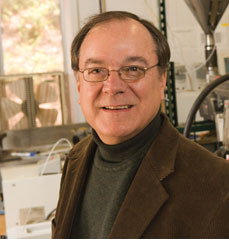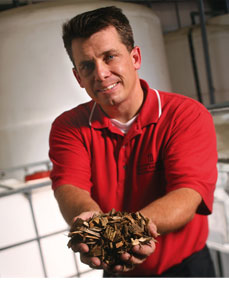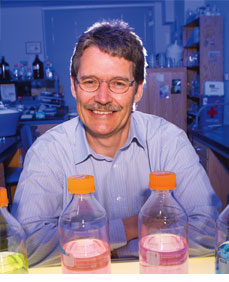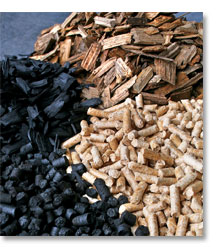




Tom Adams is developing a liquid fuel, usable in diesel engines, from harvested forest residues.
![]()

Ryan Adolphson is working to fine-tune pilot-scale technology for converting woody biomass to transportation fuels and other bioproducts such as “char,” which can be used as a fertilizer.
![]()

Biochemist Mike Adams is using the tools of molecular biology and biochemistry to engineer microorganisms that can break down biomass more efficiently.
![]()

Biochemist Will York is using this powerful NMR machine to characterize the structure of plant cell walls.
![]()
Probing the Secrets of Cellulose
So how will the nation produce the copious amounts of ethanol needed to meet its goals of the next decade? The consensus answer is cellulosic ethanol—from trees, wood debris, switchgrass, and other abundant sources of cellulose, which is the most plentiful biological material on Earth. In essence, cellulosic ethanol is more energy-efficient than corn ethanol and uses more abundant and diverse feedstocks that, unlike corn, are not used for food production.
Cellulose is the main constituent of all plant tissues and fibers. The wood in a tree may be 50 percent cellulose or more. In cotton in its raw state, that figure is about 91 percent. But while cellulose contains tremendous amounts of sugars that can be fermented into ethanol, doing so is currently much more complicated and costly than making it from corn, according to John McKissick, coordinator of UGA’s Center for Agribusiness and Economic Development.
 The main problem is that the simple sugars in cellulose are locked up in complex chains of molecules that nature remarkably created “to resist biological and chemical degradation,” says Joy Peterson, a UGA microbiologist.
The main problem is that the simple sugars in cellulose are locked up in complex chains of molecules that nature remarkably created “to resist biological and chemical degradation,” says Joy Peterson, a UGA microbiologist.
Much of Peterson’s research focuses on finding novel and low-cost enzymes that can efficiently break down cellulose, overcoming “cell-wall recalcitrance” and releasing large amounts of sugars and starch. The enzymes now used in this so-called “enzymatic process” are very costly, a major barrier to producing ethanol on a commercial basis.
Thus the DOE wants to speed up the search for inexpensive enzymes and other cost-effective ways of breaking down plant-cell walls. That is the prime motivation behind its $375-million, five-year commitment to the three new centers. Participating researchers, from UGA and other select institutions, will focus mostly on the cellulose of fast-growing poplar trees and switchgrass, which is native to the United States and can be grown with minimal effort throughout most of the country, including Georgia. One aim of the research is to develop a group of microorganisms that could break down plant matter, through an efficient one-step conversion process, into biofuels.
Investigating Alternative Processes
Meanwhile, other UGA researchers will continue their investigations into the major alternative to the enzymatic process, called the thermochemical process. In this approach, solid biomass is converted to a gaseous or liquid fuel by heating it in a limited-oxygen environment prior to combustion. Last May, Tom Adams of UGA’s faculty of engineering announced that he and his colleagues were using a thermochemical technique to produce a new biofuel from wood chips. “Compared to Fischer-Tropsch technology, it’s very easy to do,” said Adams, “and we expect to reduce the price of producing biofuels from biomass dramatically with this technique.” He added, however, that it would probably take a few years to perfect.
In Soperton, Ga., ground has already been broken for a sprawling new plant that will use another, still-proprietary thermochemical method to produce as much as 100 million gallons of ethanol a year from pine chips. If all goes as planned, the plant, being built by the firm Range Fuels, could be the first to demonstrate that ethanol can be produced from cellulose on a commercial scale. Success would give thermochemical-process proponents chest-thumping rights over supporters of the enzymatic process.
Proponents of the alternate approach, though, are laying their own plans. C2 Biofuels, a company working with Georgia Tech and UGA’s Peterson, is planning to build a cellulose-to-ethanol plant in Georgia using the enzymatic process.
There is much skepticism, however, over whether either plant will prove commercially successful, given the many unknowns about cellulosic ethanol. But Adolphson says that having such plants up and running will allow researchers to determine where adjustments or redesign might put the processes on track to becoming efficient and competitive ethanol producers.
Researchers and Funders Confident
Government is helping the prototype plants get off the ground. In February, the DOE said that Range Fuels in Soperton and five other cellulosic ethanol plants in the nation would be eligible for $385 million in construction and production grants. Range Fuels itself is in line for $76 million. Georgia has also embraced Range Fuels, offering it tax abatements, low-cost land, and grants that could total more than $10 million. In addition, U.S. Senator Saxby Chambliss of Georgia, ranking member of the Senate Agricultural Committee, has introduced a measure to boost fuel derived from pine trees and other cellulose sources.
Critics often deplore the subsidies and other special favors, but supporters, such as UGA’s McKissick, say they are very helpful and even necessary to launching a promising new technology that could be of great benefit to the nation.
Bioenergy experts say it is too early to predict which process—thermochemical or enzymatic—will emerge as the dominant technique for making cellulosic ethanol. Possibly both will enjoy considerable use when the current obstacles are overcome.
In the meantime, there are other technological and economic challenges—among them developing efficient ways of growing and harvesting biomass crops, delivering the feedstocks to biorefineries, and getting the biofuels economically into consumer fuel tanks at the filling station.
Environmental questions remain as well. For example, will massive production of cellulosic ethanol decimate our forests? Will our rivers and streams suffer from erosion caused by putting more land into biomass crops? Researchers at UGA and elsewhere are confident that the hurdles will be overcome. “We’re not there yet,” says Adolphson, “but we can see it from here.”
(Charles Seabrook recently retired from the Atlanta Journal-Constitution, where he was a science and environmental writer for 33 years).
For comments or for information please e-mail: rcomm@uga.edu
To contact the webmaster please email: ovprweb@uga.edu
![]()